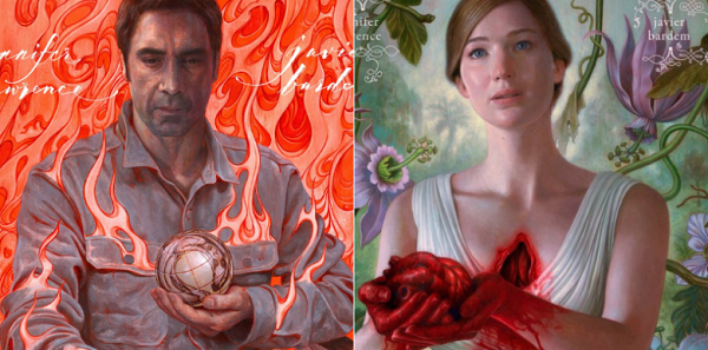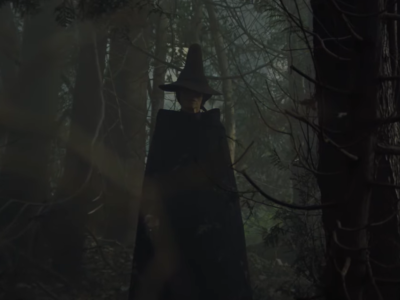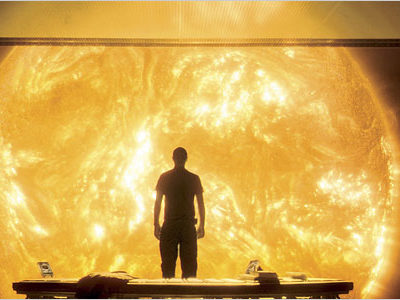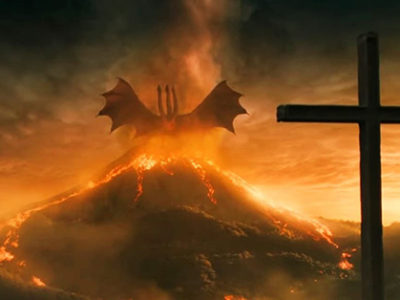Staff 2017 Top Ten| Blake Collier
This week at Reel World Theology we are featuring the top ten lists of contributors to the site. You can find all our contributor lists here, as well as links to reviews and podcasts for each movie below.
10 – The Beguiled
Sophia Coppola has been a favorite director of mine since I first saw The Virgin Suicides, a haunting film about innocence and coming of age. In The Beguiled, she turns her sites towards remaking a classic Clint Eastwood film directed by Don Siegel about a sly Union soldier taken in and cared for by the headmistress and young women and girls at a Southern girl’s school. The film came under some scrutiny for its erasure of black characters, mentions of slavery and the historical realism of the period. While this is a concerning omission by a white, female director, it remained a film I thought about throughout the year. This was, in part, due to one of my current favorite critics, Angelica Jade Bastién, who wrote a piece giving an adroit reading to the film’s text which gave me a new eyes in which to view and challenge the rendering of the film. It is far from perfect and maybe the most problematic film on my list when placed against films like Get Out, I Am Not Your Negro, and Mudbound, but I think there is more than meets the eye here and certainly more than its predecessor brought to the table both in style and substance.
9 – Mudbound
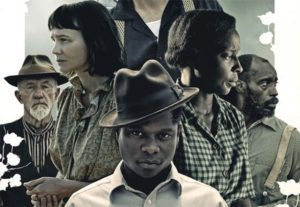 Before Mudbound had been released, I had pushed hard for people to go see Marshall instead of the more critically admired Detroit, because it told a black story from a black perspective and avoided the drastic failures of the latter in telling a black story through the filter of the white gaze. Once Mudbound came on the scene, however, I began championing it and its African American, female director, Dee Rees. This wonderful tale revolves around a piece of land in Mississippi that represents different things to the two families that live on its muddy landscape: the Jacksons—African American sharecroppers—and the McAllans—the white “owners” of the land by tradition and by privilege. When sons from each family go off to fight in World War II and come back to the farm, bonds are formed and others become tested and the bigotry that has reared its head through all of American history finds its incarnation once again. The film does not shy away from the ugly portions, but it refuses to make simple villains either. Its characters are given poignant inner lives that help us see the complexity of those times and people. It’s a film so well made and effective that it should be taught in American history courses from now on.
Before Mudbound had been released, I had pushed hard for people to go see Marshall instead of the more critically admired Detroit, because it told a black story from a black perspective and avoided the drastic failures of the latter in telling a black story through the filter of the white gaze. Once Mudbound came on the scene, however, I began championing it and its African American, female director, Dee Rees. This wonderful tale revolves around a piece of land in Mississippi that represents different things to the two families that live on its muddy landscape: the Jacksons—African American sharecroppers—and the McAllans—the white “owners” of the land by tradition and by privilege. When sons from each family go off to fight in World War II and come back to the farm, bonds are formed and others become tested and the bigotry that has reared its head through all of American history finds its incarnation once again. The film does not shy away from the ugly portions, but it refuses to make simple villains either. Its characters are given poignant inner lives that help us see the complexity of those times and people. It’s a film so well made and effective that it should be taught in American history courses from now on.
8 – The Blackcoat’s Daughter
Oz (Osgood) Perkins—the son of Psycho’s Anthony Perkins—came onto the scene with 2016’s I Am the Pretty Thing That Lives in the House, a film that one either loves or hates depending on their willingness to give into Perkin’s slow, meticulous pacing. With 2017’s The Blackcoat’s Daughter—originally known as February and actually made before I Am…—we find a story of two female Catholic school students who are left behind over the winter holidays at the school dorms where they become entangled in a demonic possession, meanwhile a mysterious young woman (played by Emma Roberts) hitchhikes across the wintery landscape towards the town which holds the Catholic school. This slow burn of a film trades jump scares for imagery and shots that get under the skin and make the supernatural evil of horror seem all the more natural. Another reason why Perkins remains on my list of favorite directors.
7 – Three Billboards Outside Ebbing, Missouri
 Martin McDonagh’s third feature film opened with a rather consistent critical approval, however once it began to receive wide play, that narrative started to shift. The reception became more devisive and pieces analyzing the film’s racial politics and tone-deafness came out in spades. I don’t disagree with some of the criticisms, but I also know that this film has to be viewed within the scope of McDonagh’s cinematic work thus far. McDonagh is consistently seeking to scrape at what actual redemption looks like on the street with human nature, violence, vengeance, justice, injustice, etc. wrapped up in it. It is a messy narrative with characters that feel like they are pulled straight from a Flannery O’ Connor story. The film has the wit and the bravado of a play (like last year’s Fences) and it has a singular mind in what it attempts to do and make people feel—hence where the criticisms could be lodged. On top of all of this, it delivered one of the best performances of the year from Frances McDormand. Follow these links for the RWT review & podcast.
Martin McDonagh’s third feature film opened with a rather consistent critical approval, however once it began to receive wide play, that narrative started to shift. The reception became more devisive and pieces analyzing the film’s racial politics and tone-deafness came out in spades. I don’t disagree with some of the criticisms, but I also know that this film has to be viewed within the scope of McDonagh’s cinematic work thus far. McDonagh is consistently seeking to scrape at what actual redemption looks like on the street with human nature, violence, vengeance, justice, injustice, etc. wrapped up in it. It is a messy narrative with characters that feel like they are pulled straight from a Flannery O’ Connor story. The film has the wit and the bravado of a play (like last year’s Fences) and it has a singular mind in what it attempts to do and make people feel—hence where the criticisms could be lodged. On top of all of this, it delivered one of the best performances of the year from Frances McDormand. Follow these links for the RWT review & podcast.
6 – I Am Not Your Negro
James Baldwin was a prominent black author who had a keen eye for dissecting the racial, class and sexual politics of American society. He was a complex voice within the cultural milieu of the mid-20th century as he took up the middle ground between Malcolm X’s more forceful approach to attaining rights and Martin Luther King’s nonviolent movement for civil rights. Like George Orwell in Britain, Baldwin longed to see the initiation of socialism in American politics and culture. Raoul Peck’s poetic documentary, I Am Not Your Negro, starts where Baldwin ended. It begins with the unfinished manuscript, Remember This House, about the lives of Malcom, Martin and Medgar, and weaves the life of Baldwin, the cultural era, and naturalistic cinematography—that would rival the later career of Terrence Malick—into a beautifully stark and profound examination of the civil rights era and the lives of the men and women who led it, lived it and wrote about it. It is a complex and beautiful documentary that defies specific classifications within the genre.
5 – Columbus
 It wasn’t until news surrounding the soundtrack for Columbus being composed by the band, Hammock (a favorite of mine), that I heard about the existence of the film or its director, Kogonada. It peaked my interest with John Cho and Haley Lu Richardson (The Edge of Seventeen) as its central characters. Kogonada has an academic pedigree and the formalism of he and Elisha Christian’s directing and framing of the film is front and center. This, however, does not make the story of the relationship between a young woman, who has pushed aside her dreams in order to care for her addict mother, and a young Korean-born man, who is stuck in Columbus, Indiana where his architect dad has fallen ill, emotionally cold and detached. There is a lot of heart that transcends each shot of this film. The modernist architecture of Columbus becomes a monument which represents the formalism and the effective beauty of the film and the bond its central protagonists create.
It wasn’t until news surrounding the soundtrack for Columbus being composed by the band, Hammock (a favorite of mine), that I heard about the existence of the film or its director, Kogonada. It peaked my interest with John Cho and Haley Lu Richardson (The Edge of Seventeen) as its central characters. Kogonada has an academic pedigree and the formalism of he and Elisha Christian’s directing and framing of the film is front and center. This, however, does not make the story of the relationship between a young woman, who has pushed aside her dreams in order to care for her addict mother, and a young Korean-born man, who is stuck in Columbus, Indiana where his architect dad has fallen ill, emotionally cold and detached. There is a lot of heart that transcends each shot of this film. The modernist architecture of Columbus becomes a monument which represents the formalism and the effective beauty of the film and the bond its central protagonists create.
4 – Mother!
mother! has become, maybe, the most divisive film of 2017, which is no surprise for director, Darren Aronofsky, but a bit of a surprise for a mainstream release from Paramount Pictures. I still cannot honestly give a concrete opinion on whether I “loved” or “hated” this film. It defied such immediate superlatives and made its way up this list merely on the struggle it created in me. Going on the strength of that struggle alone, I might be so brave as to say that this is perhaps the best piece of art I have ever witnessed. Yet, its analogies and metaphors are messy and don’t fully come to fruition and Aronofsky’s use of religious narratives and doctrines is shallow, bordering on disrespectful. It is, however, the full force of vision and bravado that should be celebrated here. It is something to be experienced fully. And it proved all of those who complained that Hollywood didn’t release anything original to be hypocrites since a good number of them didn’t go see it. That’s enough reason for it to be on this list right there. Follow these links for the RWT review & podcast.
3 – Good Time
 I was fortunate enough to see a press screening of this film with fellow film critic, Colin Stacy, in Dallas on the day of the total eclipse and, having not seen any other Safdie Brothers movies, I went into Good Time knowing nothing but what the trailer had shown me. That, in and of itself, was enough to get me intrigued. What I found upon entrance to this tale of criminal failures, loose cannon drug trips and brotherly love was a frenetic and gritty piece of cinema that never lets up and never makes judgments on the actions of the characters in the film, partially because there is no time for it and partially because the Safdies are more concerned with grace in the midst of human foibles than most filmmakers I have seen of late. Robert Pattinson and Benny Safdie turn in two of my favorite performances of the year and Oneohtrix created one of the most energetic and propulsive soundtracks of the year. It’s a hell of a ride in so many ways.
I was fortunate enough to see a press screening of this film with fellow film critic, Colin Stacy, in Dallas on the day of the total eclipse and, having not seen any other Safdie Brothers movies, I went into Good Time knowing nothing but what the trailer had shown me. That, in and of itself, was enough to get me intrigued. What I found upon entrance to this tale of criminal failures, loose cannon drug trips and brotherly love was a frenetic and gritty piece of cinema that never lets up and never makes judgments on the actions of the characters in the film, partially because there is no time for it and partially because the Safdies are more concerned with grace in the midst of human foibles than most filmmakers I have seen of late. Robert Pattinson and Benny Safdie turn in two of my favorite performances of the year and Oneohtrix created one of the most energetic and propulsive soundtracks of the year. It’s a hell of a ride in so many ways.
2 – Get Out
I never thought I would walk out of a horror film during my lifetime which would follow in the footsteps of Halloween and shift the landscape of horror from now on, but that is exactly what Jordan Peele’s debut film accomplished. A narrative written for the Obama era, post-racist naivety of American liberalism became a more terrifying and visceral mirror for the country’s current state of affairs under the Trump administration. Best viewed in the most diverse of audiences, the film is able to juggle its classic horror foundations, satirical commentary and black comedy in a way that feels of a piece during its runtime. I can only hope that this film announces the beginning of a more diverse landscape of nightmares for the horror genre. Easily the film that has stuck to my bones the longest throughout the entire year. Follow these links for the RWT review & podcast, as well as a special episode of The Body | The Blood.
1 – The Work
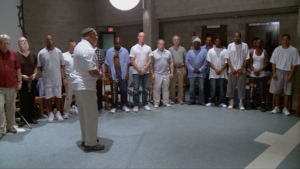 In a year of political tensions, racial unrest and ideological stalemates, the question on the minds of many is whether the American landscape will ever be able to heal from the chasms that separate us all. It is easy to succumb to cynicism and futility in these times and, yet, documentaries like The Work come along to give us a glimpse of hope and healing on an intimate scale. Three outsiders come within the walls of Folsom Prison to take part in a group therapy retreat and find themselves faced with hardened criminals from all walks of life who are continually coming to terms with their violent and abusive pasts. What happens during the film’s runtime gives us a schematic for deeply hopeful and emotionally raw work which might help us all overcome those American chasms.
In a year of political tensions, racial unrest and ideological stalemates, the question on the minds of many is whether the American landscape will ever be able to heal from the chasms that separate us all. It is easy to succumb to cynicism and futility in these times and, yet, documentaries like The Work come along to give us a glimpse of hope and healing on an intimate scale. Three outsiders come within the walls of Folsom Prison to take part in a group therapy retreat and find themselves faced with hardened criminals from all walks of life who are continually coming to terms with their violent and abusive pasts. What happens during the film’s runtime gives us a schematic for deeply hopeful and emotionally raw work which might help us all overcome those American chasms.


